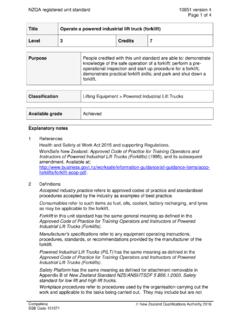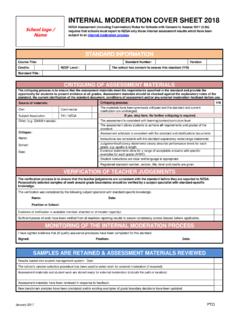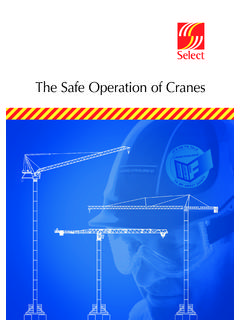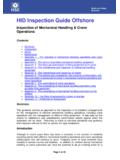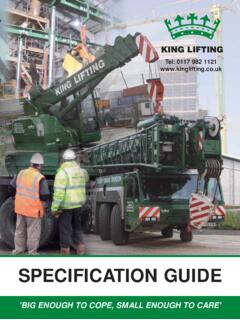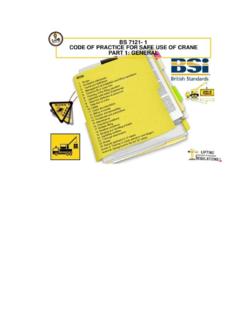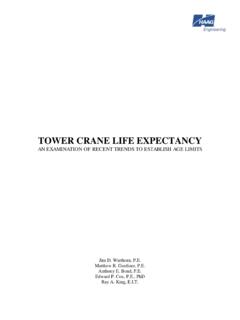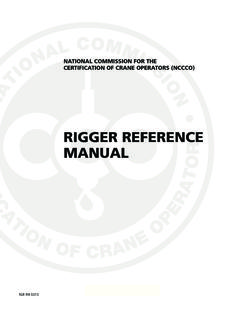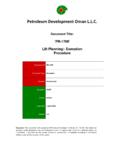Transcription of irregular loads Level 4 Credits 25 - nzqa.govt.nz
1 NZQA unit standard 3795 version 8 Page 1 of 5 The Skills Organisation SSB Code 100401 New Zealand Qualifications Authority 2019 Title Configure and position a mobile crane , and lift and place regular and irregular loads Level 4 Credits 25 Purpose People credited with this unit standard are able to: demonstrate knowledge of using a mobile crane ; configure and position a mobile crane ; lift and place regular and irregular loads with a mobile crane ; prepare mobile crane for travel mode, and complete documentation; and carry out daily and weekly operator maintenance of a mobile crane . Classification Cranes > crane Operation Available grade Achieved Prerequisite Unit 3789, Sling varied regular loads and safely direct a crane during crane operations, or demonstrate equivalent knowledge and skills.
2 Guidance Information 1 All tasks are to be carried out in accordance with the equipment manufacturer requirements, applicable company procedures, and industry good practice found in the following sources: a company quality management systems; b health and safety requirements and guidelines consistent with the Health and Safety at Work Act 2015; c equipment manufacturer operating instructions; d government and local government legislation, regulations, and bylaws; e crane Safety Manual, version or higher, available from ; f Approved Code of Practice for Cranes, 2009 (3rd edition), and/or the Approved Code of Practice for Load-lifting Rigging available from 2 Definitions crane the definition as given in the Health and Safety in Employment (Pressure Equipment, Cranes, and Passenger Ropeways) Regulations 1999.
3 crane Workplace the definition as given in Health and Safety at Work Act 2015. NZQA unit standard 3795 version 8 Page 2 of 5 The Skills Organisation SSB Code 100401 New Zealand Qualifications Authority 2019 irregular loads have one or more of the following characteristics unequal weight distribution, eccentric loading, irregular shape and proportions, with or without set lifting points. Industry good practice practice that meets the requirements of the Approved Code of Practice for Cranes, Approved Code of Practice for Load-lifting Rigging, and the crane Safety Manual. Lift plan the planning of a lift that may be in a variety of formats, in accordance with company procedures. Regular loads have the following characteristics uniform weight distribution; concentric loading or regular proportions; known lifting points; repetitively lifted.
4 Roading the crane includes understanding or demonstration of Certificate of fitness /Warrant of fitness, Registration applicable permits (national and regional road controlling authorities), swept path requirements, license and BESS requirements (Bridge engineering self supervision), crane configuration, driving on road. Risk assessment may include communication and documentation of a lift plan, toolbox talk, task analysis, or job safety analysis. 3 Assessment Cranes that can be used for assessment against this unit standard include truck mounted cranes, all terrain cranes, rough terrain cranes. Assessment cannot be carried out using truck loader cranes, or telehandlers, or excavators when being used as cranes. Assessment for competency in the use of truck loader cranes is covered by Unit 16617, Use a truck loader crane to lift and place regular loads .
5 Assessment must be carried out in a crane workplace or other non-simulated environment. Non-simulated environment means; working with the skill sets required in authentic experience in an organisational context, with commercial competence and the expectations and possible consequences of that context. Evidence used for assessment against this unit standard must meet one or more of the following requirements to prove experience: a. verified experiences from authorised verifier documented and observed lifts, or company documents with a minimum of 40 lifts (slinging and directing placement of load) with at least six variations of lifting operations that may include site, crane , loads , and communication methods; and b. at least two irregular loads , including one in which centre of gravity is offset, must be observed by the assessor.
6 4 It is recommended that Unit 31904, Plan and document lifts of regular and irregular loads using multiple cranes is completed prior to assessment against this unit standard. Outcomes and performance criteria Outcome 1 Demonstrate knowledge of using a mobile crane . Performance criteria Describe hazards associated with the operation of a mobile crane . Range includes hazards associated with roading the crane . NZQA unit standard 3795 version 8 Page 3 of 5 The Skills Organisation SSB Code 100401 New Zealand Qualifications Authority 2019 Describe the roading and traveling of a mobile crane to a workplace. Range includes but is not limited to assembling and checking required equipment, authorisation to use equipment, pre-start checks and service, fault reporting, roading the crane .
7 Describe the setting up of a mobile crane on site. Range includes but is not limited to site arrival and induction processes, permit to work, access and exiting, crane platform assessment, risk assessment, establishing exclusion zones. Explain the operation of a mobile crane . Range includes but is not limited to rating charts and range diagrams. Explain the requirements for lock out and tag out processes for the mobile crane . Outcome 2 Configure and position a mobile crane . Performance criteria Analyse task to identify regulatory requirements and permits that are needed in accordance with the lift plan, task, and site. Range may include but is not limited to Police, New Zealand Transport Agency, local body requirements, Corridor Access Request (CAR), electricity supply, telecommunications, Worksafe New Zealand, Civil Aviation Authority, Rail Corridor Requirements.
8 Analyse the workplace to identify and document hazards and risks, relating to the planned lift, and implement control measures so far as reasonably practicable. Range may include but is not limited to vehicles, equipment, ground condition, underground services, overhead power lines, overhead service lines, trees, buildings, structures, unauthorised people, exclusion zones, wind and weather, simultaneous activities. Configure and position the crane in accordance with the lift plan. Range includes configuration of blocks, outriggers, safe load indicator, boom length, anti-two-block, and establishing weight of load (before lift); may also include configuration of counterweight, operating limits, fly jib. NZQA unit standard 3795 version 8 Page 4 of 5 The Skills Organisation SSB Code 100401 New Zealand Qualifications Authority 2019 Configure ropes, reeving and parts of line, hook block, hook, and rigging equipment for the load to be lifted.
9 Carry out plant and equipment operational and safety checks. Range may include but is not limited to settlement test. Outcome 3 Lift and place regular and irregular loads with a mobile crane . Performance criteria Communicate the tasks, hazards, roles, and responsibilities to workers assisting with the lift and other persons who may be affected, in accordance with the lift plan. Check to ensure workers assisting with the lift and other persons who may be affected are in their respective positions ready to conduct their tasks. Range may include but is not limited to riggers, slingers, dogmen, supervisor. Observe and check to confirm that the load is correctly attached, and lift and place the load in accordance with the lift plan and customer requirements.
10 Range includes regular and irregular loads . Outcome 4 Prepare mobile crane for travel mode, and complete documentation. Performance criteria Prepare mobile crane for travel and store lifting and other equipment used in conjunction with the lift. Range travel includes on road and off road travel. Secure boom in travel position. Range travel includes on road and off road travel. Record and take action for any defects in crane and equipment. Complete documentation as required. Range includes but is not limited to log books, records, job sheets, crane equipment inventories, maintenance requests. NZQA unit standard 3795 version 8 Page 5 of 5 The Skills Organisation SSB Code 100401 New Zealand Qualifications Authority 2019 Outcome 5 Carry out daily and weekly operator maintenance of a mobile crane .



